GPU Tahiti of AMD from Islands Southern
family was announced about one and a half year ago, but AMD seems not to rush with this new version. Yes, and on the really, it actually
should not, because AMD platform product seems to have competitive with Nvidia
foundation partners in all price segment. Therefore, the partners of AMD have
nothing to do besides polishing their solutions and provide something
especially as ASUS ROG Matrix 7970 that was released recently. Design for
extreme overclocking process and stuff with different technologies, in fact
Radeon HD 7970 GHz is fastest available at the moment. We will check its
features and benchmark its system in our today’s review.
Packing and Accessories
The cardboard box contains ASUS ROG Matrix
7970 as wide as the typical motherboard box:
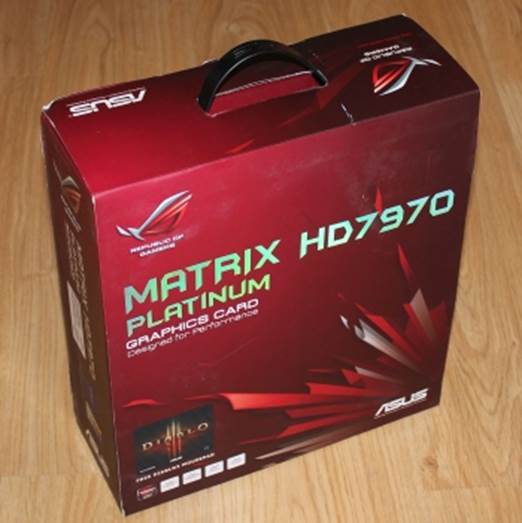
Cardboard
So, there are many words on the product
description packing and technology that contains in it.
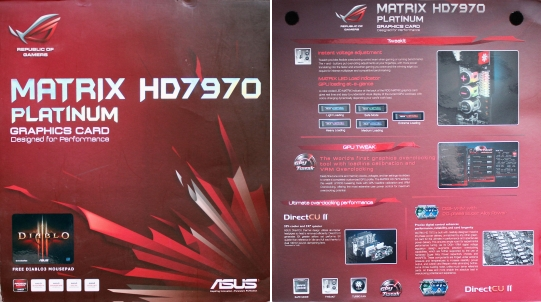
The
product information is printed on the box
The lid at the top can be opened to reveal
more information about ASUS ROG Matrix 7970 and to have a look at the graphics
card through a plastic window.
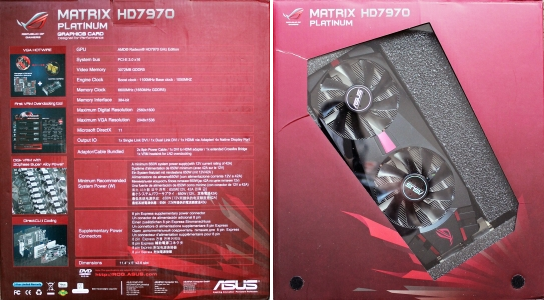 .
.
The
product information is printed on the box
There are many accessories inside: a power
cable, DVI-> HDMI rectifier and DVI-> VGA, a CrossFireX bridge, a VGA
Hotwire cable to connect the card with the ROG motherboard model, a heat-sink
for the replaced rectifier voltage, a ROG sticker, and a CD with drivers and
utilities.

Accessories
As a great added bonus, a Diablo 3 mouse
pad is in the box although no game included. Manufactured in China, ASUS ROG
Matrix 7970 is for $549 with 3 years warranty.
Functionality and PCB design
ASUS ROG Matrix 7970 can make an impressive
with anyone by its surface. The shell has matte black of its cooling device
with the red and two large fans make it very stylish.

Design
The back of PCB is covered by a perforated
metal plate you can read the name of the model. The “Matrix” on the top edge of
the card is highlighted:

The
back of PCB
This device is 285x140x59 mm wide, so it
will take 3 PCIe slots on the motherboard. They recommend taking the fourth
slot for the card cooler device works effectively.
The installation frame of card looks
spectacular with two DVI connections and four DisplayPorts ports. You can
connect up to six monitors at the same time but there are certain nuances. You
can only use a DVI in the dual-link mode with a DisplayPort port or you can use
two DVI ports in the single-link and allow all four DisplayPorts.

The
connection ports
The operation mode of the video port is
determined by a small BIOS switch, you can find near MIO CrossFireX connection
port. Three small buttons can be found on the other side of PCB – we will
explain our purpose right below. Beside there is a switch for the fan at their
maximum speed.
Instead of an 8-pin and 6-pin power
connection, ASUS ROG Matrix 7970 is equipped with two 8-pin connections:
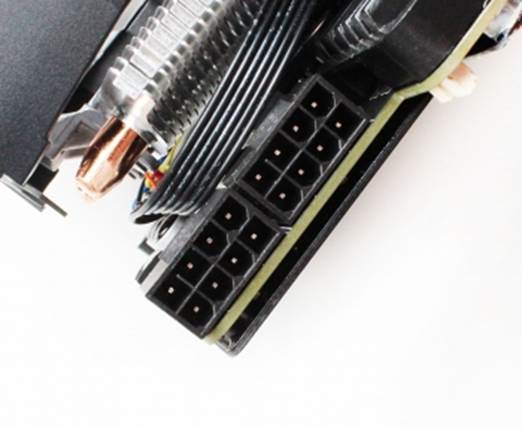
The
detail design
It might look as expected because ASUS ROG
Matrix 7970 is defined to consume up to 300 watts, 50 watts more than the rules
of the original of AMD Radeon HD 7970 GHz Edition. A 650 watts PSU is
recommended for a computer with a ROG Matrix 7970 inside.
Two MIO connections for CrossFireX
configuration building process can be found in the usual place. The switch that
you use to select the operating mode for video output port of the card can be
seen in the picture:
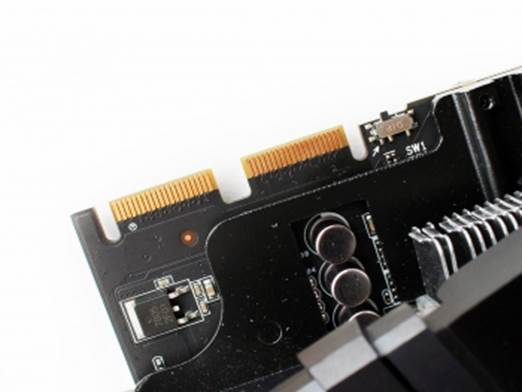
The
detail design
Consider three slots in the form factor,
ASUS ROG Matrix 7970 can hardly be used in CrossFireX configurations with more
than one additional card.
After removing the cooling device, we find
PCB that is mostly covered by a metal heat-sink sheet with some leaves.
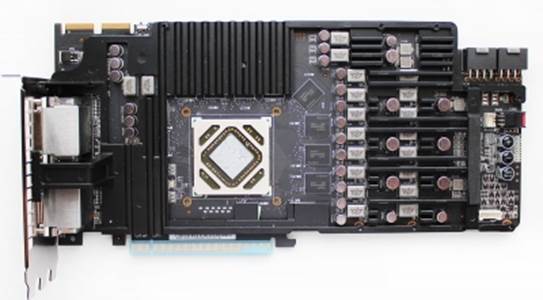
Mainboard
design
It is responsible for cooling the
electrical system components and some memory chips. There is a heat-sink of the
components to be used if the card is cooled by liquid nitrogen or Freon cooling
device.
ASUS ROG Matrix 7970 has the custom PCB
with the high quality components and durable (ASUS Super Alloy Power
technology). Adjust GPU voltage up to 16 phases and it is managed by the
ASP1211 DIGI + digital controller. There are four phases for the memory chip and
other circuitries, so the total of power phase is 20. iROG chip that is installed
in the upper of PCB seems to be responsible for communications between the
graphics card and the ROG motherboard from ASUS via the VGA Hotwire surface.
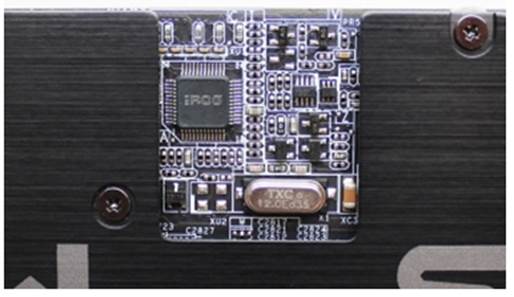
Electronics
system
It provides the hardware controller over
all parameters of the graphics card via UEFI BIOS or the ASUS AI Suite
software.
There are three buttons next to the turbo
switch in the cooling fan device.
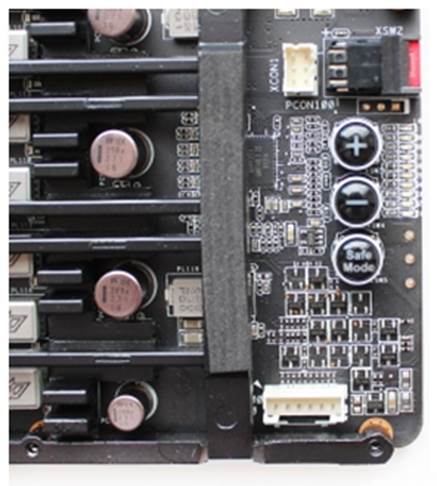
The
voltage regulator
The "+" and "-" button
can be pressed to adjust the voltage on each step even if the graphics cards
increase and active – this process is accompanied with a colorful sign. Press
Safe Mode button to make the graphics cards to reset and restart with its
default settings.
Hardcore overclocking may appreciate the
contacts and connections they can use to measure and increase the voltage and
enable LN2 mode.
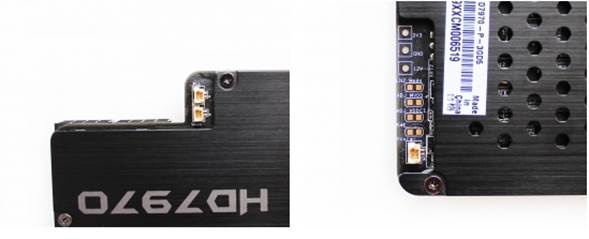
Hardcore
overclocking
Overall, ASUS ROG Matrix 7970 is not only a
very fast graphics card, but also a perfect tool for anyone who wants maximum
overclocking performance.
Its Tahiti TX is quite normal:
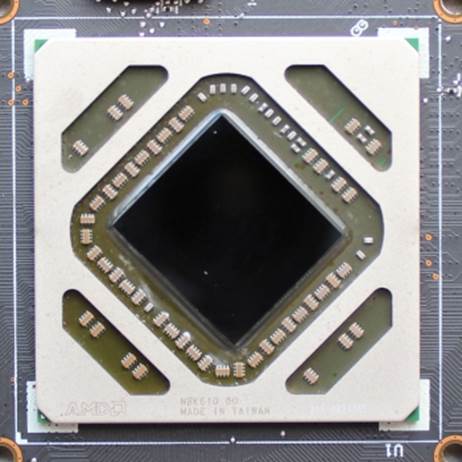
Chip
Tahiti TX
It has standard technical specifications.
The latter is increased to 1,050-1,100 MHz. Specifications suggest that this is
the increased clock speed, but graphics card actually works at 1,100 MHz with
3D applications, not only at high load. So, we can assume that 1,100 MHz
actually has the default GPU clock speed of GPU ASUS ROG Matrix 7970 for 3D
applications.
This graphics card is equipped with 3G
GDDR5 memory chip in H5GQ2H24AFR R0C Hynix Semiconductor chip.
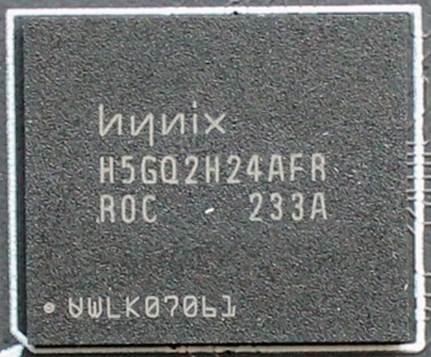
Hynix
Semiconductor H5GQ2H24AFR R0C chip
The memory chips are set to 6,000 MHz
speed, but ASUS pre-overclocked at 10%, up to 6,600 MHz. Thus, ASUS ROG Matrix
7970 is really the fastest production version of Radeon HD 7970.
Here is a summary of the graphic card’s
specifications:
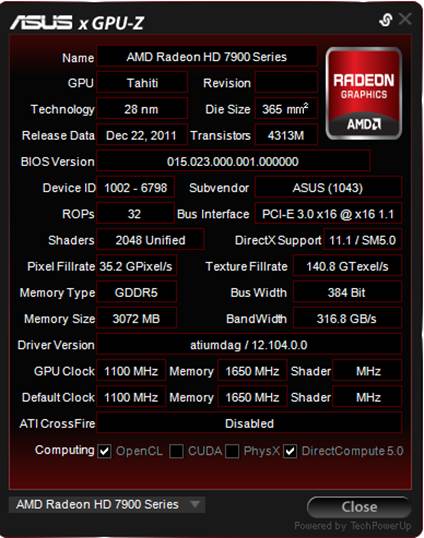
Technology
standard